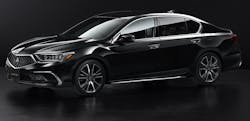World's First Level 3 Self-Driving Production Car Now Available in Japan
If you’ve been keeping up with market predictions about when a fully approved SAE level 3 automated vehicle would hit the market and which automaker would be first to do it, you might have been surprised at last week’s announcement from Honda.
Following approval by the Japanese government of its “Traffic Jam Pilot” system, Honda became the first carmaker to sell a vehicle equipped with certified level 3 self-driving technology. That means the automated driving system can drive the vehicle instead of the driver under certain conditions, such as when the vehicle is in congested traffic on an expressway.
Level 3 vehicles, also known as conditional driving automation vehicles, have “environmental detection” capabilities. As a result, drivers are able to engage in activities behind the wheel, such as using smartphones, under limited conditions while their car accelerates past a slow-moving vehicle or otherwise navigates expressway traffic.
Lease sales of the level 3 Honda domestic market Legend sedan will be limited to 100 cars at a retail price of 11 million yen ($102,000).
Most global automakers that develop autonomous-driving technology, such as General Motors Volvo, Tesla and Toyota, currently offer vehicles equipped with a level 2 partial automation system. Level 3, as the name implies, is a step up. It means a car can read its environment and make decisions based on what it sees.
Honda Sensing Elite's Traffic Jam Pilot function gives the car control over its brakes, steering, and throttle. This lets the car maintain a following distance, speed, and lane position. It does all this with no input from the driver. The level 3 system uses data from 3D high-definition maps and a global navigation satellite system for vehicle control, as well as a dozen external sensors that detect the car's surroundings.
A Honda Sensing Elite-equipped car can drive behind another vehicle at a preset speed and a safe distance while staying centered in its lane. If the system notices the car ahead is lagging below the set speed, the system notifies the driver and then assists with passing and returning to the original lane. If it's safe to change lanes, the driver can flick the turn signal to trigger a safe pass of the vehicle ahead. The Legend can pilot itself where traffic is congested and doesn’t require constant monitoring by the driver, says the company.
The system can alert the driver to respond when handing over the control, for example via vibration on the driver's seatbelt. If the driver is unresponsive, the system will assist with an emergency stop by decelerating and stopping the vehicle on the shoulder while alerting surrounding cars with hazard lights and the horn. If there’s no shoulder, the vehicle will creep to a halt with its hazard lights flashing and blasts of the horn.
While the system is engaged on the highway, drivers don’t need to have their hands on the steering wheel. The driver can change lanes by activating the turn signal while the system is engaged. However, the system can also scan the road and initiate lane changes on its own to pass vehicles while on the highway, all without driver intervention, according to Honda.
Tesla’s Autopilot and Cadillac’s Super Cruise can do some of these things, but both of those systems and others currently on the market require the driver's attention in all situations. With Honda’s level 3 Traffic Jam Pilot, the driver and the system “will share the driving task," says Yoichi Sugimoto, who oversees driver-assistance technology at Honda R&D. The Traffic Jam Pilot is the first step in this process, “and we would like to assess how autonomous driving is welcomed at the Japanese market.”
Honda says it simulated some 10 million patterns of possible real-world situations, and conducted 800,000 miles of real-world testing before it decided the system was ready.
Currently, the Japanese automaker has no plans to bring the Legend with this system to the U.S.
Under an agreement with the Japanese government, the vehicle will include a data recorder to track its movements and external signage to make other road users aware of its autonomous capabilities.

